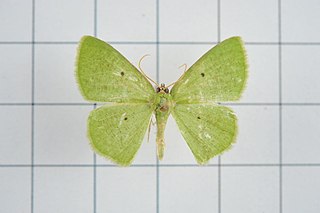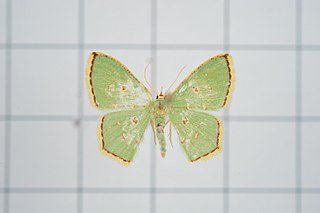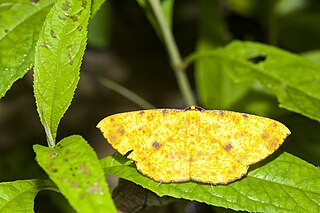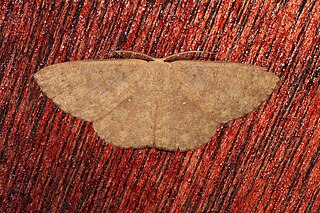Related Research Articles

Symmacra is a monotypic moth genus in the family Geometridae described by Warren in 1896. Its only species, Symmacra solidaria, was first described by Achille Guenée in 1858. It is found in Indo-Australian tropics of India, Sri Lanka, Borneo east to Fiji, Samoa and Australia.

Aplochlora vivilaca is a moth of the family Geometridae first described by Francis Walker in 1861. It is found in Sri Lanka, Indian subregion, Taiwan, Borneo and Sulawesi.

Calletaera postvittata is a moth of the family Geometridae first described by Francis Walker in 1861. It is found in the Indian sub-region, Sri Lanka, Taiwan, and Sundaland.

Celenna festivaria is a moth of the family Geometridae first described by Johan Christian Fabricius in 1794. It is found in India, Sri Lanka, Myanmar, Borneo, Java Taiwan, the Ryukyu Islands and Luzon in the Philippines.
Chorodna strixaria is a moth of the family Geometridae first described by Achille Guenée in 1858. It is found in India, Vietnam, Sulawesi, the Philippines, the Moluccas, New Guinea, Australia and Sri Lanka.

Cleora alienaria is a moth of the family Geometridae first described by Francis Walker in 1860. It is found in Sri Lanka, the Indian subregion to the Andaman Islands, Thailand, Sundaland, Taiwan, and Lesser Sundas as far east as Timor and Christmas Island.
Comostola chlorargyra is a moth of the family Geometridae first described by Francis Walker in 1861. It is found in Sri Lanka, the Indian subregion, the Andaman Islands, Borneo, Java, the Philippines, Sulawesi and Australia.

Comostola subtiliaria is a moth of the family Geometridae first described by Otto Vasilievich Bremer in 1864. It is a widespread species which is found in Korea and adjacent parts of Siberia, Japan, Borneo, Sumatra, India, South China, Taiwan, Borneo, Sumatra, and Sri Lanka.
Cyclothea disjuncta is a moth of the family Geometridae first described by Francis Walker in 1861. It is found in Sri Lanka.

Eucyclodes semialba is a moth of the family Geometridae first described by Francis Walker in 1861. It is found in Sri Lanka, the north-east Himalayas of India, Myanmar and Sundaland.

Eumelea ludovicata is a moth of the family Geometridae first described by Achille Guenée in 1858. It is found in Indo-Australian tropics of India, Sri Lanka, east to Singapore, Taiwan, the Solomon Islands and Guam.
Gonanticlea occlusata is a moth of the family Geometridae first described by Felder in 1875. It is found in the north-eastern Himalayas of India, Sri Lanka, Tonkin, Peninsular Malaysia and Borneo.
Idaea marcidaria is a moth of the family Geometridae first described by Francis Walker in 1861. It is found in Sri Lanka, Myanmar, China, Taiwan, Singapore and Borneo.
Idaea semisericea is a moth of the family Geometridae first described by Warren in 1897. It is found in the north-eastern Himalayas of India, Sri Lanka, Borneo, Java and the Philippines.
Maxates acutissima is a moth of the family Geometridae first described by Francis Walker in 1861. It is found in India and Sri Lanka.
Maxates coelataria is a moth of the family Geometridae first described by Francis Walker in 1861. It is found in Sri Lanka and from the Indian subregion to Sundaland.
Pelagodes clarifimbria is a moth of the family Geometridae first described by Prout in 1919. It is found in Sri Lanka, Peninsular Malaysia and Borneo.

Perixera absconditaria is a moth of the family Geometridae first described by Francis Walker in 1862. It is found in the Indian subregion, Sri Lanka, to Taiwan, Sundaland and the Philippines.
Probithia obstataria is a moth of the family Geometridae first described by Francis Walker in 1861. It is found in Sri Lanka and Australia.

Anuga multiplicans is a moth of the family Noctuidae first described by Francis Walker in 1858. It is found in India, Sri Lanka, Hong Kong, Korea, Taiwan, Philippines and Borneo.
References
- ↑ "Species Details: Synegia imitaria Walker, 1861". Catalogue of Life. Retrieved 17 March 2018.
- ↑ Koçak, Ahmet Ömer; Kemal, Muhabbet (20 February 2012). "Preliminary list of the Lepidoptera of Sri Lanka". Cesa News. Centre for Entomological Studies Ankara (79): 1–57 – via Academia.
- ↑ "HOSTS - a Database of the World's Lepidopteran Hostplants". The Natural History Museum. Retrieved 17 March 2018.
- ↑ "Synegia imitaria Walker". The Moths of Borneo. Retrieved 17 March 2018.
- ↑ "Infraspecific Taxon Details: Synegia imitaria malayana Prout, 1925". Catalogue of Life. Retrieved 17 March 2018.
| This Ennominae-related article is a stub. You can help Wikipedia by expanding it. |